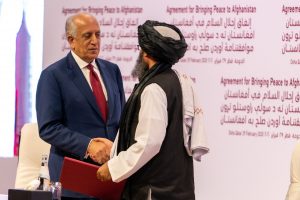There are several strong reasons to believe that Afghanistan is finally heading toward a durable peace. But other indicators suggest the post-February 29 situation may plunge the country into a new war instead of opening a window to a new beginning. Either the risks are overstated, or the level of optimism is too high. Which is it?
Right now, at the very early stage of the so-called new beginning, the peace process has hit the first snag – as expected.
Afghanistan’s President Ashraf Ghani, whose government always responded with measured enthusiasm to the U.S.-Taliban negotiations, refused to accept the release of 5,000 Taliban prisoners from Afghan jails as a precondition for the beginning of the promised intra-Afghan dialogue. The prisoners’ release “cannot be a prerequisite for talks,” Ghani told journalists in Kabul.
In a knee-jerk reaction, the Taliban announced an end to the week-plus “reduction in violence” and ordered its field commanders and fighters to launch attacks against the Afghan government and security forces.
Interestingly, when the Taliban military commission ordered attacks on Afghan government and security forces on March 2, it also asked its fighters not to target foreign forces. “We will issue fresh orders about the ‘invaders’ in the days ahead,” says the Pashto-language Taliban announcement.
Hours later, a bomb planted on a motorcycle went off during a football match in southeastern Afghanistan killing three people and injuring over a dozen on March 2.
The short-lived partial ceasefire, which was welcomed across Afghanistan with jubilation, came to an end less than 48 hours after the signing of the U.S.-Taliban agreement in Doha on February 29.
Apart from Ghani-Taliban discord over the prisoners’ release, the post-election political wrangling in Kabul is also far from over.
As Ghani is getting ready to be sworn in as the president of Afghanistan for a second term, his election rival Dr. Abdullah Abdullah and his supporters are busy holding parleys with allies to nominate governors for provinces under their influence, mostly in Afghanistan’s north and western regions. Abdullah has already threatened to declare a parallel government if Ghani takes the oath of office as president.
The deal signed in Doha by U.S. peace envoy Zalmay Khalilzad and Taliban leader Mullah Abdul Ghani Baradar on February 29 was the first and probably the easiest phase in bringing an end to the four decades of bloodshed in Afghanistan.
The intra-Afghan dialogue seems to be an uphill task, especially at a time when Ghani and Abdullah have locked horns over the results of the September 28, 2019 presidential election.
Apart from the Taliban and the Afghan political leadership, includes both Ghani and his opponents, various ethnic and religious groups and former warlords and strongmen are also an unsolicited but unavoidable part of the conflict and its resolution. Afghanistan’s decades-long struggle includes the anti-Soviet jihad followed by the bloody civil war, the emergence and overthrow of the Taliban, and the post-9/11 Taliban insurgency. Add to that the complex tribal and ethnic structure of Afghanistan, and one would need a magic wand to unite all groups, factions, and parties on a single platform within days or even weeks.
As it stand, the expected March 10 deadline for the beginning of the intra-Afghan dialogue, is a difficult, if not impossible, goal in a country already divided over the election row.
Without a reconciliation between Ghani and Abdullah, any expectation of a meaningful dialogue with the Taliban leadership is wishful thinking. And if the two rivals’ political differences flare up into full-blown ethnic and political trouble, the situation may go out of control. Unless the two sides resolve their differences — or the international community steps in to help — there is no reason to expect the commencement of the long-awaited intra-Afghan dialogue.
Afghans may be known for their abilities in taking up arms and fighting their opponents, but they have an even stronger capacity to sit for peace negotiations and achieve a compromise.
Even as the Afghan government and the Taliban have resumed attacks on each other, their respective delegations have reportedly opened diplomatic channels to find a compromise to end the deadlock. The real stumbling block, in this regard, is the intra-Afghan differences. As long as the election row continues, Ghani may not be able to develop consensus on the formation of a delegation for the intra-Afghan dialogue.
The Taliban, so far, have been successful mainly because their organizational structure and command and control authority remained intact, their military might is far from subdued, and their diplomatic outreach is felt and accepted far beyond Afghanistan’s neighborhood. Political divisions in Kabul will further weaken the Ghani government and the Afghan leadership, and automatically contribute to further strengthening the Taliban.
The Taliban resumption of attacks on the Afghan government is serving two immediate purposes: To help keep their fighters engaged and to keep the Afghan government under pressure. It is likely that the two sides, with the help of regional players and Afghanistan’s international backers, will find an agreeable midpoint sooner than later.
However, even if hostilities continue, the Taliban may not be able to pose a formidable threat to the Kabul government as long as the Afghan leadership avoid starting a post-Soviet style factional war; the military and other security agencies stay intact; and the United States and international community continue financial support for the Afghan government.
The Taliban’s victories in the mid-1990s, apart from their military prowess, were the result of a welcoming attitude by common Afghans who were fed up with the years of anti-Soviet “jihad” and civil strife. That thinking, however, is now replaced by a high degree of awareness among Afghans. And the Taliban of 2020 are fully conscious of that reality. They will settle their differences once the Afghan leadership come to terms with each other.
































